|
BEST 1760 American display newspaper with a long detailed front page eyewitness report of the BATTLE OF QUEBEC Canada during the FRENCH & INDIAN WAR - inv # 2A-110
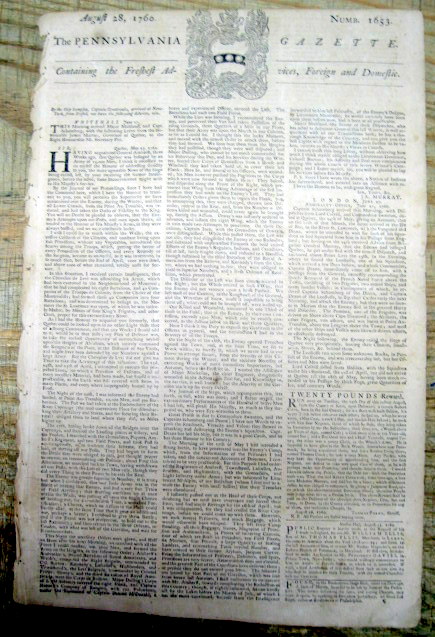 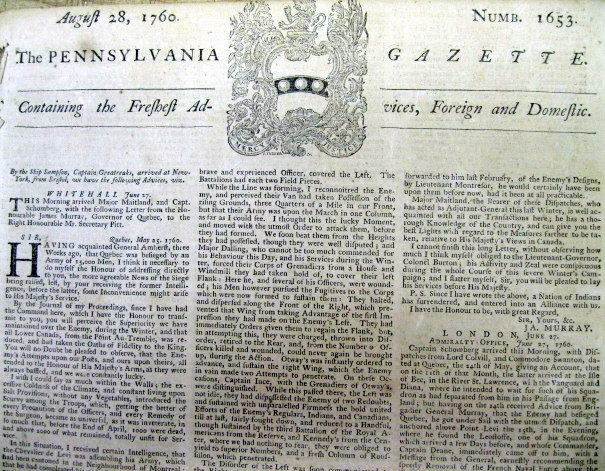 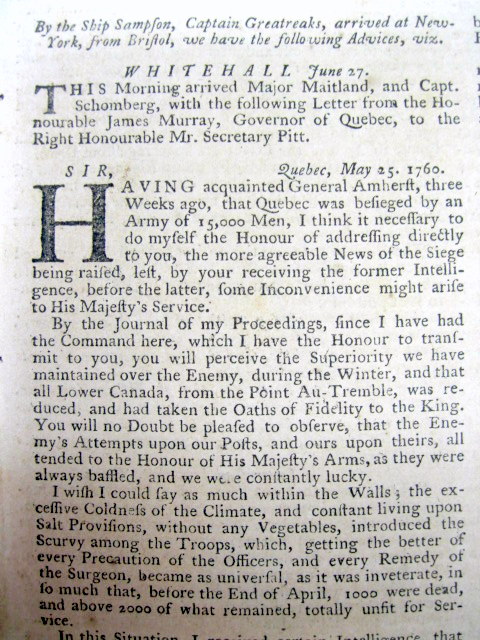 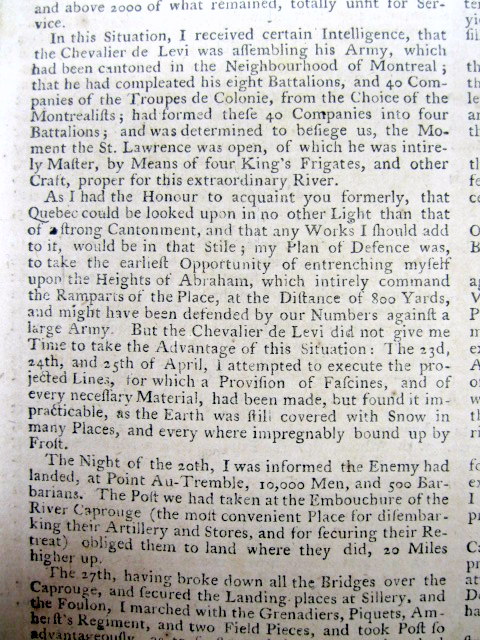 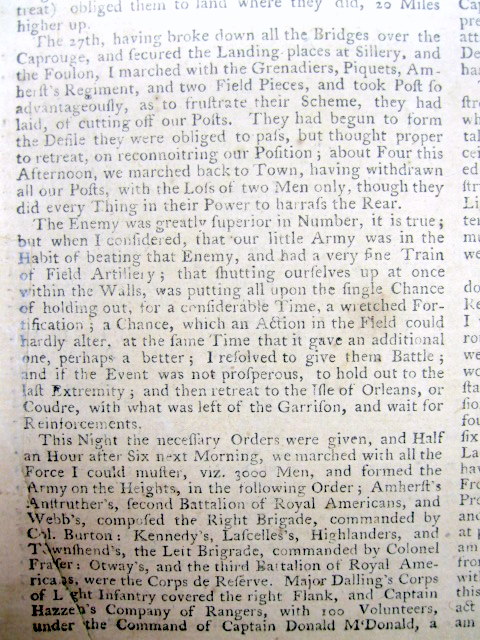 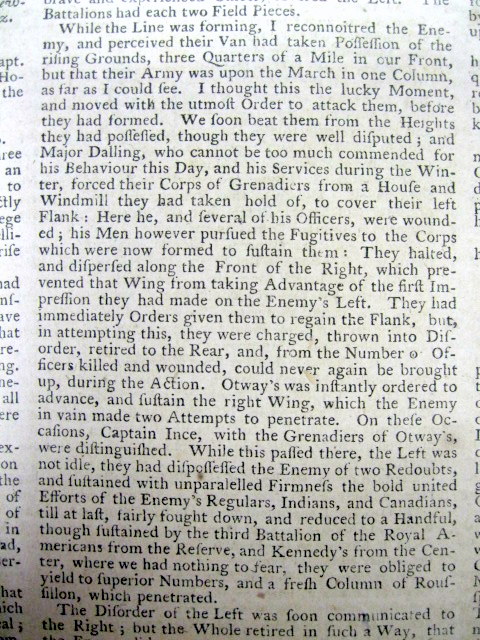 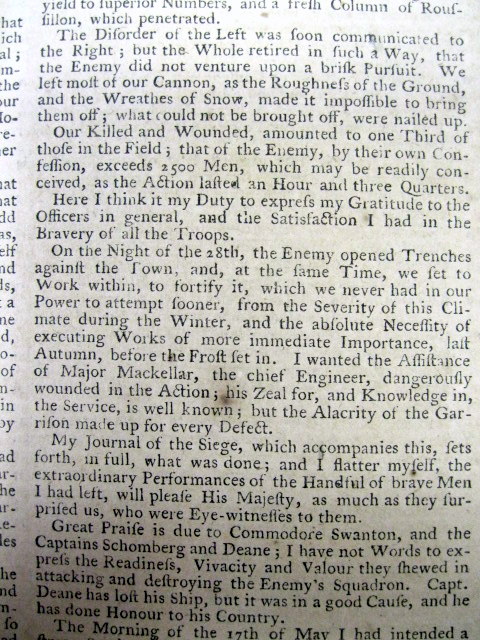  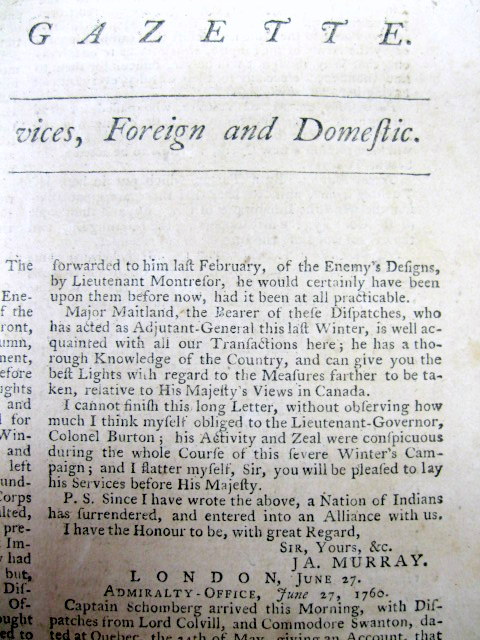
Please visit our EBAY STORE at the link directly below for HUNDREDS of HISTORICAL NEWSPAPERS on sale or at auction:
http://stores.ebay.com/Steve-Goldman-HISTORICAL-NEWSPAPERS_W0QQsspagenameZL2222QQtZkm
SEE PHOTO----- A complete front page of an ORIGINAL NEWSPAPER, the Pennsylvania Gazette (Philadelphia, PA) dated Aug 28, 1760. This newspaper contains a complete printing in 3 columns (all on the front page) of a detailed eyewitness account of the BATTLE OF QUEBEC (Canada) during the French and Indian War (this was also known as the BATTLE of SAINTE-FOY). This long detailed account was written, and signed in type, by British General James A Murray, the British Colonial Administrator of the Province of Quebec during the French and Indian War.
This is the BEST display newspaper I have seen with a complete front page eyewitness account of the BATTLE of QUEBEC during the French and Indian War. It lacks the back page; however, it would be perfect for framing and display !!!
General James Murray (21 January 1721, Ballencrieff, East Lothian, Scotland – 18 June 1794, Battle, East Sussex) FRS was a British soldier, whose lengthy career included service as colonial administrator and governor of the Province of Quebec and later as Governor of Minorca from 1778 to 1782. His term in Quebec was notably successful, and marked with excellent relationships with the conquered French-Canadians. who were reassured of their traditional rights and customs.
Murray served under General James Wolfe at the Battle of the Plains of Abraham in 1759. Murray believed Wolfe's plan to land the army at Anse au Foulon was foolish and absurd, and succeeded "only by Providence". He was the military commander of Quebec City after it fell to the British. Lévis managed to defeat Murray and the British in the Battle of Sainte-Foy in 1760, but he had to abandon the siege of Quebec due to a lack of supplies and the arrival of a British relief fleet.
The Battle of Sainte-Foy, sometimes called the Battle of Quebec, was fought on April 28, 1760 near the British-held town of Quebec in the French province of Canada during the Seven Years' War (called the French and Indian War in the United States). It was a victory for the French under the Chevalier de Lévis over the British army under General Murray. The battle was notably bloodier than the Battle of the Plains of Abraham of the previous September, with 833 French casualties to 1,124 British casualties. It was the last French victory of the French and Indian War.
At first the British had some success, but the advance masked their artillery, while the infantry became bogged down in the mud and melting snowdrifts of the late spring. The battle turned into a two-hour fight at close range; eventually, as more French soldiers joined the fray, the French turned the British flanks, forcing Murray to realize his mistake and to recall the British back to Quebec without their guns, which Lévis then turned on the city.
New France had suffered significant setbacks in the 1758 campaigns of the French and Indian War. Its fortress at Louisbourg was lost in a siege by British forces, and Fort Duquesne was abandoned to another advancing British army. The situation got worse in 1759 when Fort Carillon and Fort Niagara were taken, and the key citadel of Quebec fell after a prolonged siege and the Battle of the Plains of Abraham of September 13, 1759. The French army regrouped in Montreal under General Chevalier de Lévis. Meanwhile, the British army, left behind in Quebec after the fleet sailed at the end of October 1759, suffered from hunger, scurvy and the difficulties of living in a city that they had largely destroyed in the siege.
In April 1760, Lévis returned to Quebec with an army of over 7,000 men, including Canadien militia and First Nations warriors. He hoped to besiege Quebec and force its surrender in the spring, when he expected a French fleet to arrive.
General James Murray, left in command at Quebec, felt that his army was too small to adequately defend the walls of Quebec, which had not been improved since the British capture of the town. He therefore moved some 3,800 men into the field, all he could muster, along with over twenty cannon, to the same position that Montcalm had occupied for the 1759 battle. Rather than waiting for the French to advance, however, he took the gamble of going on the offensive.
Lévis commanded 6,910 soldiers, including 3,889 in eight regular battalions. Compagnies Franches de la Marine comprised two more battalions. The remainder of his army was made up of Canadien militia, plus a handful of native allies. Of this force, approximately 5,000 and only three cannons were present on the field of Sainte-Foy.
Murray's 3,886-man force consisted of ten regular battalions, a converged light infantry battalion, and two companies of rangers. In order to cover the entire plateau, the battalions were each drawn up in two ranks with three-foot gaps between files, instead of the normal elbow-to-elbow formation. There were 40-yard intervals between battalions. The light infantry covered the right flank. In order, from right to left, were the 48th Foot, 15th Foot, 58th Foot, 2nd battalion of the 60th Foot, 43rd Foot, 47th Foot, 78th Foot, and 28th Foot. The rangers and some volunteers covered the left flank. In reserve behind the right flank stood the 35th Foot, while the 3rd battalion of the 60th formed the left flank reserve. The infantry were supported by 20 cannons and two howitzers. One sergeant recorded that the British army was "a poor pitiful handful of half starved scorbutic skeletons."
Observing that the French army was still deploying, Murray resolved to strike his enemies before they were ready. As the British advanced, Lévis pulled his three formed right wing brigades back into the Sillery Woods. At this time, the French left wing had not yet deployed. The British light infantry drove some French grenadiers out of a windmill on the right flank. Pursuing, they soon ran into trouble. The French left wing troops aggressively attacked and scattered the light infantry. Murray committed the 35th Foot from his reserve and restored the right flank of the British line. However, a bitter struggle for possession of the windmill continued.
The British army suffered 292 killed, 837 wounded, and 53 captured, for a total of 1,182 casualties. The French lost 833 men, including 193 killed and 640 wounded. The 15th Foot lost 138 out of 386 soldiers of all ranks, or 34% casualties. Three-quarters of the officers of the Fraser Highlanders (78th) were killed or wounded. This makes the Battle of Sainte-Foy one of the bloodiest engagements ever fought on Canadian soil.
Lévis was, however, unable to retake Quebec. The British retreated behind the city's walls, and withstood Lévis' feeble siege until the arrival of naval reinforcements in May. The French fleet never arrived, because France's naval hopes were smashed at Quiberon Bay the previous fall and the few supply ships sent from France were lost in the Bay of Chaleur in the Battle of Restigouche. HMS Lowestoffe raised its flag as it neared Quebec followed by HMS Diana, and HMS Vanguard under Commodore Swanton which then destroyed Levis' support ships on the Saint Lawrence. He quickly raised the siege and retreated to Montreal, where he surrendered in September to overwhelming British forces that approached the city from three directions.
This newspaper contains National and International news as well as LOCAL ads and news from
Very good condition. This listing includes the front page (pages 1 and 2 of a 4-page newspaper) of an original newspaper. STEPHEN A. GOLDMAN HISTORICAL NEWSPAPERS stands behind all of the items that we sell with a no questions asked, money back guarantee. Every item we sell is an original newspaper printed on the date indicated at the beginning of its description. U.S. buyers pay priority mail postage which includes waterproof plastic and a heavy cardboard flat to protect your purchase from damage in the mail. International postage is quoted when we are informed as to where the package is to be sent. We do combine postage (to reduce postage costs) for multiple purchases sent in the same package. We accept payment by PAYPAL as well as by CREDIT CARD (Visa and Master Card). We list hundreds of rare newspapers with dates from 1570 through 2004 on Ebay each week and we ship packages twice a week. This is truly SIX CENTURIES OF HISTORY that YOU CAN OWN!
Please check out our constantly updated offerings by doing a seller search by clicking on the address below:
http://cgi6.ebay.com/ws/eBayISAPI.dll?MfcISAPICommand=ViewListedItems&since=2&userid=qrst&include=0&rows=200
Please visit our EBAY STORE at:
http://stores.ebay.com/Steve-Goldman-HISTORICAL-NEWSPAPERS_W0QQsspagenameZL2222QQtZkm
Stephen A. Goldman Historical Newspapers has been in the business of buying and selling historical newspapers for over 40 years. Dr. Goldman is a consultant to the Freedom Forum Newseum and a member of the American Antiquarian Society. You can buy with confidence from us, knowing that we stand behind all of our historical items with a 100% money back guarantee. Let our 40+ years of experience work for YOU ! We have hundreds of thousands of historical newspapers (and their very early precursers) for sale. |



















